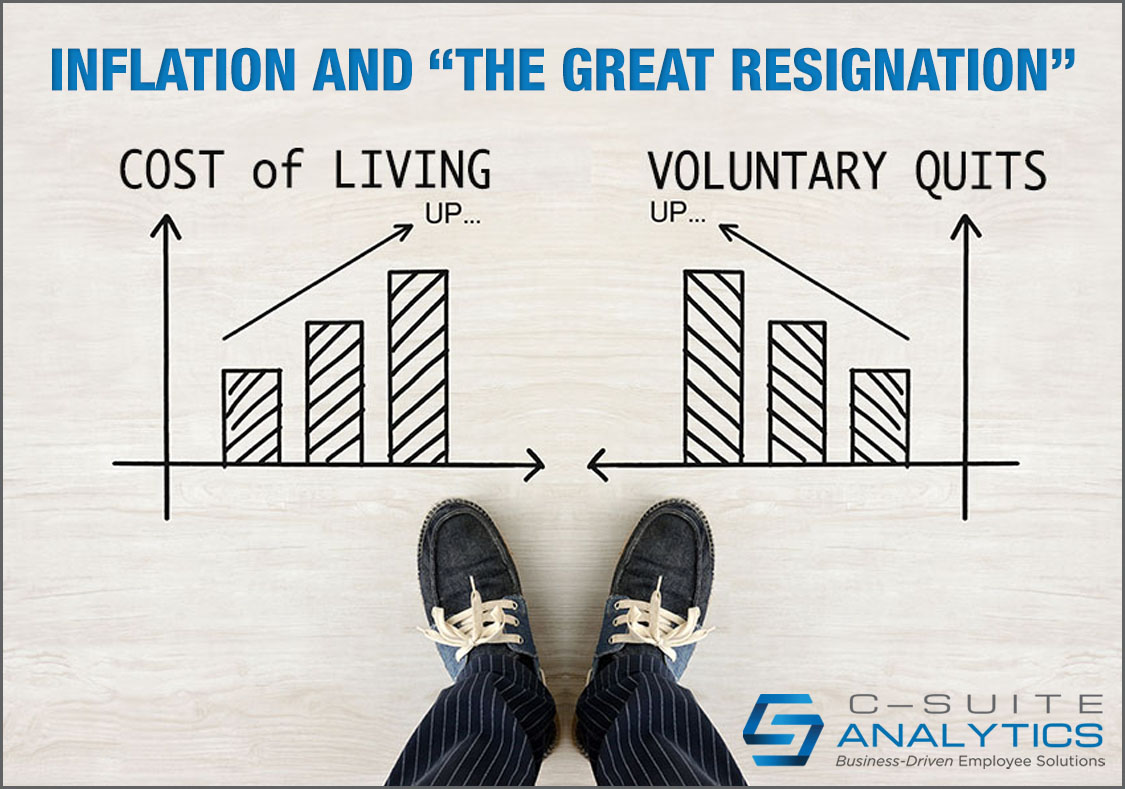Most hiring tools answer whether candidates can and will do the job, but not if they’ll stay. Learn how realistic job previews and motivational-fit interviews can improve retention from day one.
Inflation and “The Great Resignation”

Inflation across the U.S. is impacting all consumers, all businesses, and threatening politicians’ careers. It’s the can’t-be-avoided domestic news topic, maybe even leaping ahead of “The Great Resignation”. And a new report indicates these two topics are directly connected.
More reasons economists see no end in sight for “The Great Resignation”
The report is from economic think tank Burning Glass, titled The Demographic Drought: Bridging the Gap in Our Labor Force.[i] And here’s the eye-grabbing punchline:
“If immigration does not improve…I’m not sure how we get back to growth.”
The bottom line is there are no longer enough American workers to fulfill the demands of our economy. Just not enough. I’ve reported earlier here that there are now 11.3 million open jobs which we are trying to fill with 6 million fewer workers than before the pandemic. Tossing in “supply chain”, another news-grabbing term, report author Ron Hetrick says this: “All of our gaps in the supply chain are because people aren’t there to make the goods.”
Where did our workers go? Here’s a brief summary:
- The U.S. birthrate has been slowing for the past 70 years, culminating in 2021 being our lowest birthrate in history.
- Baby boomers leaving the workforce then creates a huge hole among available workers.
- Those baby boomers stayed an average of 8 years 3 months with their employers whereas millennials stay an average of just 2 years 9 months.
- 2 million of those baby boomers retired earlier than demographics predicted during Covid, further depleting the workforce.
- Then another 2 million parents, mostly women, stayed home with their children during those times…and most have not returned to work.
- And many of the one million who lost their lives from Covid would be working beside us today.
These are indisputable facts…and are the reasons why economists see no end in sight for “The Great Resignation”. Workers just have far too many choices. One study indicates our current decade offers the smallest growth of available workers in history, putting aside the post-civil war years when there were too few remaining men to father new children.
Raising pay during “The Great Resignation” only increases inflation
Then there are the values issues that have also been measured, the significant number of workers who are choosing to work on their own, who are shunning corporate schedules, bosses, and other requirements to traditional work.
What then of immigration as a solution? Applications for HB-1 visas hit their lowest point in a decade during 2021. These are the visas that for example technology companies sponsor in order to bring coveted scientists and technology gurus into our workforce. One study blames this decrease on the “political climate” of the U.S., whereas other reports say Canada is opening their arms further to attract those high-skilled workers who are rejecting America. How times have changed.
The scarcity of workers has resulted in the usual “solutions” of raising pay and posting jobs online. This despite widespread reports that employees are quitting due to “toxic corporate culture”, with pay noted as the #16 leave reason by a recent MIT study. The irony is raising pay further increases inflation.
Customized employee retention planning combats “The Great Resignation”
All signs, then, point back to improving employee retention. And Gallup research screams loudly that fixing corporate cultures requires each individual supervisor building the best, most productive culture at her level versus at the top. The premier skill for building that culture has been and always will be establishing trust, both building it and feeling it back.
I didn’t invent Stay Interviews because I forecasted a pandemic and a resulting “The Great Resignation” craze. But I did see a massive hole in the ways we prepare leaders to develop trust with their teams. The Stay Interview process works in simple ways to produce massive, documented improvements in employee retention and engagement by doing this:
- Instructs leaders on all levels to ask their teams five specific questions in 1-on-1 individual meetings.
- Trains leaders to ask, listen, probe, and take notes such that those five questions grow into twenty questions or more.
- Next to listen and learn what is most important to that employee regarding work.
- Then build plans to leverage that employee’s strengths and interests while fixing the day-to-day issues that trouble that employee the most.
Accountability matters of course, as our readers know those first-line leaders have more impact on employee retention and engagement than anyone else on your payroll.
In last week’s blog I mentioned a consultant who left his six-figure job because his highest priority became taking his daughters to soccer practice. No one-size-fits-all policy will keep that employee from quitting your company. Its customized employee retention plans from here on out.
Looking in our rear-view mirrors, the indisputable demographics we face today make retaining and engaging our teams the equivalent of climbing ninety-degree cliffs compared to 2019…which seems like such a short time ago.
Employee Retention Even During “The Great Resignation”? Yes!
Schedule a conversation with me at DFinnegan@C-SuiteAnalytics.com to discuss your roadblocks and I’ll share ideas for how you can move forward and what is working for other companies to cut turnover by 20% and more, even during “The Great Resignation” that may benefit you.
[i] A video version of the report is here: https://www.economicmodeling.com/webinars/the-demographic-drought/#:~:text=Labor%20Economist%20Ron%20Hetrick%20shares,state%20of%20the%20market%20is.



